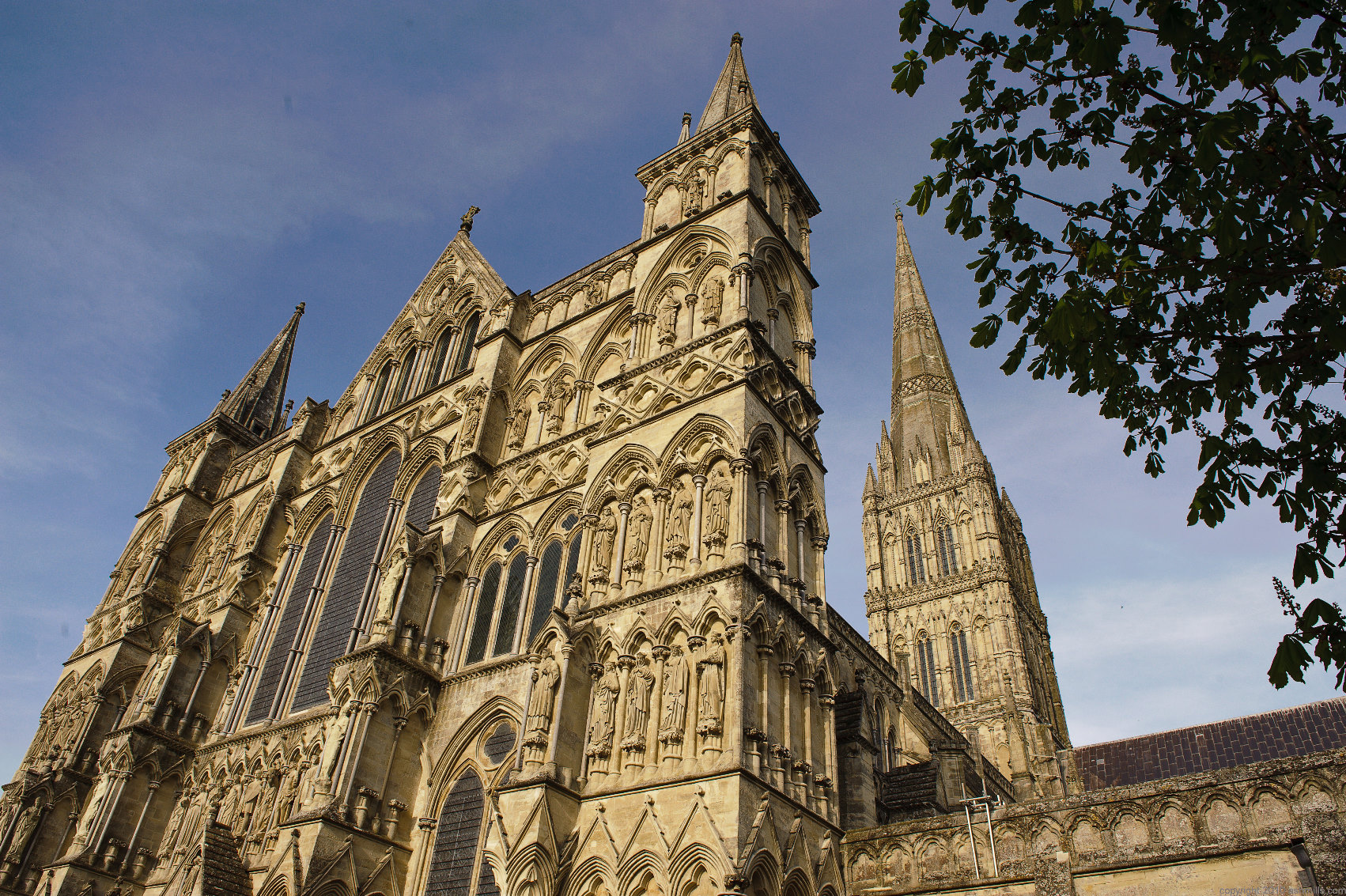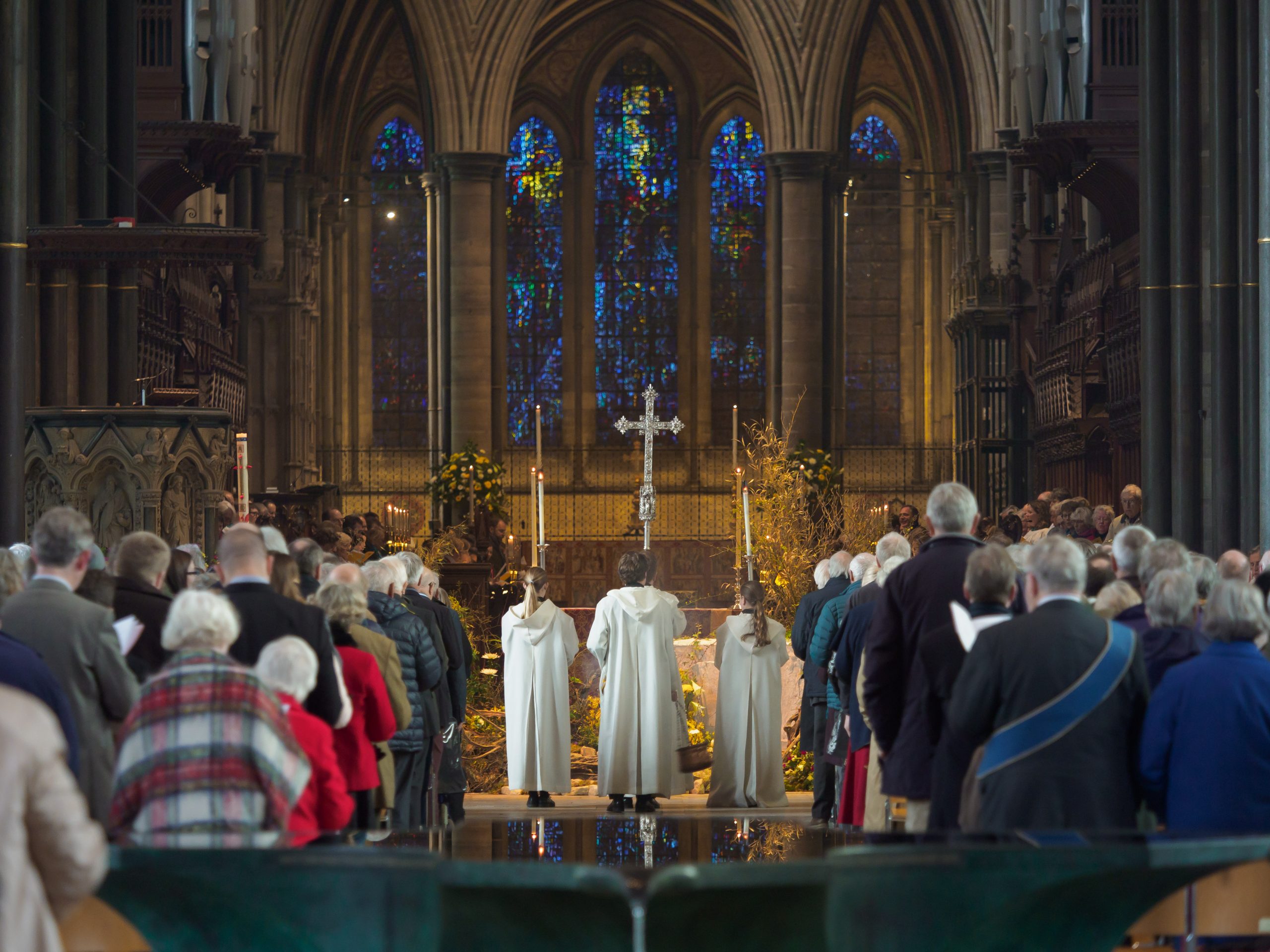A sermon for the Feast of Dedication of Salisbury Cathedral

A sermon preached by Kenneth Padley, Canon Treasurer.
Sunday 25 September, The Fifteenth Sunday after Trinity, Sunday Eucharist.
Ephesians 2.19-22; John 2.13-22
A story is told about Napoleon walking the streets of Paris. The Emperor passed a small building from which emanated the sound of uncontrollable weeping. Napoleon dispatched an officer to discover what misfortune had taken place. The officer returned to report that the building was a synagogue, and that the congregation were mourning the destruction of their great temple in Jerusalem. ‘How is this possible?’ replied Napoleon. ‘We have heard nothing of this event from our intelligence!’ The officer replied that the tragedy had taken place over 1700 years earlier and that it was the 9th day of the Jewish month of Av, an annual fast which recalls the destruction of Herod’s Temple by the Romans in AD70. Napoleon was said to be impressed, declaring that ‘a people which so intensely mourns the loss of their temple after close to two millennia is a people destined for a glorious future’.
I find this a deeply moving story. It is also of significance for us because, as we will see shortly, the destruction of the Temple in Jerusalem shaped Christian as well as Jewish thinking about holy places, albeit in a different direction.
Before that I talk about that, it is a duty and delight on a Feast of Dedication to congratulate all those involved in the life of the local church. Whether you are a weekly member of the congregation, online worshipper, occasional visitor, or here for the first time, thank you for joining a stream of prayer which goes back hundred years.
In addition, maybe you are one of our amazing volunteers, teams who work tirelessly to preserve and promote the things of God in and through this place. In worship we have Stewards and Servers, Coffee Assistants and Chalice Administrants. Around the week we have Guides, Chaplains, Pastoral Assistants; Flower Arrangers, Holy Dusters, volunteer Conservators and more. If you might be able to lend time to one or more of these ministries, please visit the Volunteer pages of the Cathedral website or speak with one of the clergy or stewards afterwards.
Another form of dedication to mission is regular faithful giving. If you have shown support through regular donations during the last year, once again, a very big thank you on behalf of us all. Direct Debit is the best way for Christians to support their local church because it prioritises giving alongside our other high-level outgoings. Information about becoming a regular donor is on the Planning Giving leaflet which you can find on the Community Forum notice board in the south aisle.
So a Feast of Dedication celebrates the local Christian community and its place of worship. However, it is worth remembering that in the first three centuries after Jesus, Christians had no church buildings. At about the same time the Romans destroyed the Jewish Temple in Jerusalem, Christians stopped worshipping in synagogues and became independent congregations. This drove Christians underground: they met in one another’s homes because they were not allowed public places of assembly. For this reason, our Bible readings today discuss metaphorical temples, not churches of bricks and mortar. In John chapter 2, Jesus contrasts the fate of the Temple in Jerusalem with his own body: the former would be ruined but the latter would rise again. And so his followers interwove their understanding of his resurrection with a sense that they were a ‘body’ corporate, and a spiritual Temple. These two images, body corporate and spiritual Temple were pliable enough to affirm a common identity but one which was collated from diverse skills and callings. As we heard St Paul tell the Ephesians, ‘you are … members of the household of God, built upon the foundation of the apostles and prophets, with Christ Jesus himself as the cornerstone. In him the whole structure is joined together and grows into a holy temple in the Lord; in whom you also are built together spiritually into a dwelling-place for God.’
This idea that Christians are a spiritual Temple also lies at the heart of the two words which we use for Christian communities of faith.
First, we have the English word ‘Church’. This Anglo-Saxon term shares a root with the German word ‘kirche’. Ultimately it derives from the Greek word ‘kurios’ which means ‘Lord’. Literally, ‘Church’ is ‘of the Lord’. The term reminds us that Christian community is centred not on a place but on the Lord Jesus.
Second, we have that family of words which include the French ‘Eglise’, Welsh ‘Eglwys’ and related English words such as ‘ecclesiastical’. All these derive through Latin from the Greek word ekklēsia. Ek-klēsia is a compound word that means ‘called-from’. In its pre-Christian context, an ekklēsia was a secular political gathering, a communal moot to which residents of a village or town might be summoned, called from their daily tasks to debate matters of shared interest. The Christian ekklēsia is also summoned, albeit to a different end: we are called from self-centred brokenness into salvation in Christ, called from mundane busyness into lives of holiness.
Understanding our common life as ekklēsia is vital. This is because it helps frame a healthy approach to time and to built heritage. It is a public misconception that the Church is backward looking and antiquated – a misrepresentation in which Christians sometimes tragically collude. However, the etymology of ekklēsia demonstrates that the truth is diametrically opposite: Christians are called from – including called from the past and into God’s future. Christians are therefore inherently prospective, forward-looking.
Our church buildings reflect this truth. Many, including this gothic masterpiece, face east – the rising sun, God’s new day, his constantly unveiling future. In addition, church buildings are never static: they have always evolved, adapting their layout and contents to serve the needs of the gospel in each generation. Bishops Herman, Osmund and Roger built the first cathedral at Old Sarum in order to cosy up to Norman power. Elias of Dereham laid out this new Cathedral when the diocese needed to escape that overbearing civil interference. Successors added our infamous fourteenth-century spire and a fifteenth century shrine to Osmund (by then a saint), which shrine was promptly torn down as idolatrous at the Reformation. Inside the Cathedral, decoration has come and gone – and come back again. Outside, the Close has progressed from marshy farmland, through a graveyard, into a busy mixed community of houses, schools, museums, and green space, a blessing for visitors and locals alike. The last century gave us electric lighting and central heating. The twenty first century has bequeathed a magnificent flowing font. And what next? Even a church with a history like this must be responsive to the movement of God in every age. We collude with a secular agenda if we fall into the fallacy of thinking that our buildings are fixed and that Church is an artefact rather than a community which faces the rising sun.
I would not seek the destruction of this Temple so that a French dictator might wish us a glorious future. But on this festal day we remember that our dedication is not a building served by a community but a living Church which serves together in a building. Ultimately, our dedication is to a relationship, and to the seemingly crazy notion that the execution of a rural carpenter within the shadow of Herod’s Temple was the epoch-shaking centre of all things. Amen.




